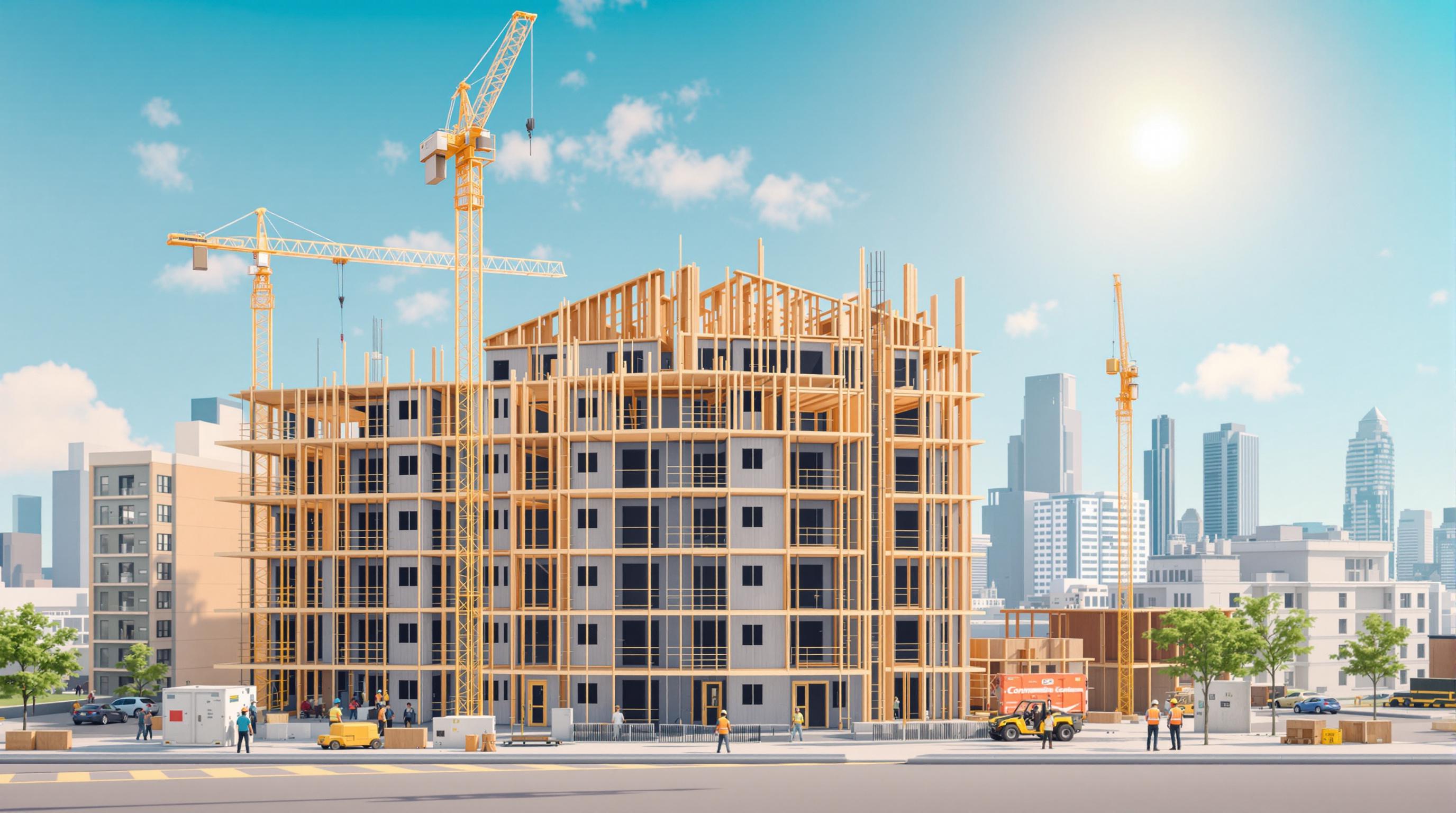By combining Accessory Dwelling Units (ADUs), multi-unit properties, and Airbnb rentals, you can diversify income streams, boost returns, and meet growing housing demand. This guide breaks down everything you need to know:
- ADUs: Add 35% to property value, cost 25–50% less to build than standalone homes, and offer flexible rental options.
- Multi-Units: Provide steady long-term rental income and address HRM’s housing shortage (17,500 units short in 2022).
- Airbnb Rentals: Generate higher nightly rates with short-term flexibility, but must comply with HRM’s updated regulations.
Quick Comparison of Key Points
| Strategy | Benefits | Challenges |
|---|---|---|
| ADUs | Affordable to build, boosts value | Requires zoning approval |
| Multi-Units | Stable monthly income | Higher upfront costs |
| Airbnb | High nightly rates | Strict regulations, daily oversight |
With HRM’s zoning changes and rising property demand, combining these strategies creates a profitable, flexible portfolio. Ready to get started? Let’s dive into the details.
The Beginner's Guide to ADU Investing
ADU Development Guide
Adding an ADU can increase rental income and boost home values by approximately 35% [5]. Below, we’ll break down the types of ADUs available and how local regulations impact their construction.
ADU Types and Uses
ADUs come in various styles to suit different property layouts and investment goals:
- Detached ADUs: Standalone units that provide privacy and design freedom but come with higher costs and longer construction times.
- Attached ADUs: Great for properties with limited yard space, offering a more space-efficient option.
- Garage Conversions: A budget-friendly and faster way to add living space by repurposing existing structures.
- Internal Conversions: Transform spaces like basements into living areas with minimal changes to the home’s exterior.
- Junior ADUs (JADUs): Small units (up to 500 square feet) integrated into single-family homes, offering a more affordable way to add extra living capacity [2][3].
HRM ADU Zoning Rules
The Centre Plan has simplified ADU construction in HRM suburbs, making it easier for homeowners to understand their options. Under ER-1 zoning, single-family homes can add either a secondary suite or a backyard suite with up to two floors [1]. All ADUs must meet specific requirements, including:
- Separate entrances
- Minimum ceiling height standards
- Proper utility hookups
- Allocated parking spaces
- Compliance with building permits [4]
The allowable size for ADUs depends on lot size and zoning rules [2].
ADU Funding Options
When it comes to financing, homeowners have several options:
- RenoFi Loans: These loans consider the home’s post-construction value, allowing for higher borrowing limits [5].
- Home Equity Loans: Fixed-rate loans with repayment terms of 5 to 15 years.
- Construction Loans: Funds are released in stages but require a more detailed approval process.
"ADUs are a way for homeowners to play a big part in expanding our city's housing stock and make some extra money while they're at it." – Los Angeles' Mayor Eric Garcetti [5]
Helio Urban Development offers investor-friendly ADU builds at $168 per square foot. They provide pre-designed plans, financing assistance, and help with government incentives.
Multi-Unit Property Development
Multi-unit properties offer a great way to increase rental income, especially with HRM's housing shortage. In 2022, the region was short by 17,500 units, and this number could climb to 31,000 by 2027 [6]. Similar to ADU projects, multi-unit developments can help stabilize cash flow and provide multiple income streams.
Multi-Unit Zoning and Design
Recent zoning changes in HRM encourage denser housing options, including townhouses and smaller multi-unit buildings [6]. When planning a multi-unit property, focus on these key aspects:
- Unit Mix: Design layouts that maximize rentable space while staying compliant with building codes.
- Amenities: Features like in-unit laundry, plenty of storage, and dedicated parking make units more appealing.
- Energy Efficiency: Opt for systems that lower energy use and operating expenses.
- Soundproofing: High-quality insulation minimizes noise between units, improving tenant satisfaction.
Helio Urban Development provides pre-designed duplexes starting at $175 per square foot. These include three bedrooms, 2.5 baths, attached garages, upscale finishes, and layouts tailored for investors. Thoughtful design is a crucial step toward securing funding for your project.
Multi-Unit Project Funding
Here are some funding options to consider:
| Funding Source | Key Features | Requirements |
|---|---|---|
| Housing Accelerator Fund | Part of $79.3M in federal funding [6] | Must align with HRM's housing objectives |
| CMHC Co-Investment Fund | Combines grants with favorable loans [7] | Typically geared toward non-profit projects |
| Traditional Construction Loans | Standard market rates | Requires strong credit and a sufficient down payment |
| Development Partnership | Shares risks and resources | Needs clear and detailed partnership terms |
These approaches, combined with ADU and short-term rental strategies, can help maximize returns on investments in HRM's suburban areas.
sbb-itb-16b8a48
Airbnb Rental Setup

Combining short-term rentals (STRs) with ADUs and multi-unit properties can increase returns when following HRM regulations. This approach allows for added flexibility and higher income potential.
HRM Short-Term Rental Rules
HRM identifies two types of STRs:
| Type | Requirements | Living Arrangement |
|---|---|---|
| Residential STR | Zoning Confirmation Letter ($200) | Host must live in the rental unit |
| Commercial STR | Development Only Permit ($250) | Host does not need to live on-site |
To operate an STR in HRM, follow these steps:
- Register with the Municipal Residential Rental Registry (one-time registration).
- Sign up with Nova Scotia's Tourist Accommodations Registry (annual registration, $50–$150).
- Obtain the appropriate permit based on your STR type.
- Comply with bedroom limits (maximum of 3 bedrooms per unit) [9].
"Prior to September 1, 2023, short-term rental regulations were not consistent across the municipality, and in most places, STRs were not permitted", explains the HRM Planning Department [8].
These regulations provide a framework for managing Airbnb properties, which is explored further in the next section.
Airbnb Property Management
Managing Airbnb rentals effectively requires a structured approach, especially for multiple units. Here are the essentials:
-
Registration and Compliance
Keep thorough records of registrations, permits, and maintenance schedules. Non-compliance can result in fines of up to $10,000 per day [9]. -
Property Standards
Ensure properties meet high standards by focusing on:- Regular cleaning
- Routine inspections
- Emergency repairs
- Amenity updates
- Clear and prompt guest communication
-
Booking Management
Streamline operations with systems for:- Guest screening
- Check-in processes
- Maintenance coordination
- Review management
Once management systems are in place, the next step is setting the right pricing strategy.
Airbnb Rate Setting
Pricing your Airbnb correctly is key to maximizing revenue.
"Overpricing invites negative reviews", warns Dave Stokley, who manages over 60 short-term rentals [10].
| Strategy | Purpose | Implementation |
|---|---|---|
| Seasonal Adjustment | Align with market demand | Raise rates in summer, lower them in winter |
| Event-Based | Leverage local events | Increase rates during festivals or conferences |
| Length of Stay | Promote longer bookings | Offer discounts for weekly or monthly stays |
| Gap Fill | Reduce vacant nights | Discount isolated single-night stays |
"Seasonality is a good place to start to make more revenue. It's one of the easiest things to implement as a pricing strategy", says Jordan Locke, a revenue expert in the rental industry [10].
For better results, use dynamic pricing tools instead of relying on Airbnb's Smart Pricing feature. Keep in mind that property management fees usually fall between 20% and 50% of the rental income [11].
Combined Property Strategy
Managing various rental types - like ADUs, multi-unit properties, and short-term rentals - requires careful planning to balance risks and maximize income. By blending different rental approaches and aligning them with market demand and local zoning rules, investors can create a more flexible and profitable portfolio.
Income and ROI Analysis
Understanding the financial performance of different rental strategies is essential. For instance, a 750-sq-ft detached ADU in Halifax's Bedford area, built at a total cost of $348,000 with 8% financing, brought in $34,320 annually as a short-term rental. This translates to a 9.86% ROI [12]. In Halifax's high-demand areas, long-term rentals typically generate around $2,600 per month [12], while short-term rentals can earn between $3,500 and $5,000 monthly [12].
By comparing these numbers, investors can decide whether to focus on steady, long-term income or higher short-term gains, adjusting their strategies to match market conditions. These insights are also key to choosing the right tools for managing the properties effectively.
Property Management Systems
Managing a mix of rental types efficiently often requires reliable software. Some popular platforms include:
- Buildium: Starting at $58 per month, this platform is ideal for mixed portfolios, offering tenant portals and maintenance tracking.
- AppFolio: Custom pricing makes it suitable for larger portfolios, with features like automation and integrated accounting.
- SimplifyEm: At $40 per month, it’s a cost-effective option for smaller portfolios, handling up to 2,000 units.
A recent study found that 84% of property managers saved significant time by using property management software [14].
Risk Prevention Methods
Minimizing risks is just as important as maximizing income. Here are a few strategies to protect your investments:
- Security Measures: Use integrated systems with access control and surveillance, especially for properties catering to both long-term and short-term renters.
- Regular Maintenance: Schedule inspections and upkeep to prevent small issues from escalating and affecting multiple units.
- Financial Safeguards: Set up separate accounts for each rental type and maintain a financial buffer for unexpected vacancies, as recommended by industry experts [12].
Legal and Tax Requirements
Staying on top of legal and tax rules is crucial for managing a mixed rental portfolio effectively.
Required Permits
In HRM suburbs, specific permits are necessary for ADUs, multi-unit properties, and short-term rentals. The Additional Dwelling Unit Team handles permits for:
- Up to two internal ADU units
- One detached ADU unit
- Modifications to multi-residential properties
For multi-residential property changes, the Building Engineering team reviews permits. If your property is within a Heritage Conservation District, you'll also need a Heritage Permit. Make sure any contractors you hire have valid licenses.
Permits are just one part of the equation - understanding tax and insurance responsibilities is equally important.
Tax and Insurance Needs
Property taxes in HRM depend on location and how the property is used. Here are the key rates for the 2024/25 fiscal year:
| Tax Component | Residential Rate | Commercial Rate |
|---|---|---|
| Urban General | $0.659 per $100 | Varies by zone |
| Suburban General | $0.626 per $100 | Varies by zone |
| Climate Action | $0.019 | $0.077 |
| Fire Protection | $0.014 | $0.034 |
| Education | $0.017 | $0.042 |
For mixed-use properties, having the right insurance coverage is critical. Consider these types:
- Commercial Landlord Insurance for property damage and liability
- Business Interruption Insurance to cover rental income loss
- Property Insurance for structures and shared spaces
- Liability Coverage for legal claims
HRM Housing Law Compliance
Legal compliance aligns with HRM's zoning rules. Here’s what property owners need to do:
-
Obtain Zoning Approval
Ensure your property complies with regulations for both residential and commercial uses. -
Maintain Regular Inspections
Keep records of all inspections and maintenance activities. -
Monitor Tax Obligations
Residential tax bills are going up by 6.3% (an average of $214) in 2024/25 [15]. Required documentation includes:- Property tax payments
- Rental income reporting for income tax
- HST collections for short-term rentals
- Special area rates for community facilities
Working with tax professionals and legal advisors can help you stay compliant while taking advantage of available deductions and credits.
Conclusion
Main Points Review
Using a mixed-property approach in HRM suburbs can diversify income sources and offer financial advantages. For example, Accessory Dwelling Units (ADUs) are 25–30% cheaper to build than traditional single-family homes and can be completed in just 4–6 months [16]. This strategy combines long-term rental stability with the potential for higher short-term earnings.
Here’s a quick breakdown of the potential benefits:
| Component | Financial Benefit | Time Investment |
|---|---|---|
| ADU | Tax savings up to $2,500/year [16] | Minimal upkeep |
| Multi-Unit | Consistent monthly income | Standard management |
| Airbnb | Higher nightly rates [13] | Requires daily oversight |
With these clear advantages, you're ready to take the first steps toward implementing this strategy.
Getting Started Steps
-
Evaluate Your Property
- Use the ExploreHRM tool to check zoning requirements.
- Review current HRM housing policies.
-
Secure Necessary Approvals
- Zoning Confirmation Letter: $200
- Development Only Permit: $250
- Tourist Accommodation Registry: $50–$150, depending on bedroom count [9].
-
Optimize Your Layout
- Design spaces to maximize rental earnings while staying compliant with HRM regulations.
- Consider including home office spaces to appeal to remote workers [19].
HRM Housing Outlook
Here’s what the housing market looks like moving forward:
- The median sales price reached $525,000 in December 2024, a 12.9% increase compared to the previous year [17].
- Suburban areas like Timberlea, Prospect, and St. Margaret's Bay saw 23 sales in January 2025 [18].
- In the Halifax-Dartmouth region, home sales grew by 17.9% between January 2023 and January 2025 [17].
With a growing focus on eco-friendly development and the rise of remote work [19], mixed rental properties remain a promising investment choice.
Related Blog Posts
- 5 Most Profitable Multi-Unit Property Types in Nova Scotia
- 7 Ways to Maximize Rental Income with Multi-Unit Properties in Nova Scotia
- Demographic Tides: Analyzing Youth Migration & Retirement Inflow in Nova Scotia’s Housing Market
- Bridging Generational Demand: Millennials vs. Retirees in HRM’s Housing Market



